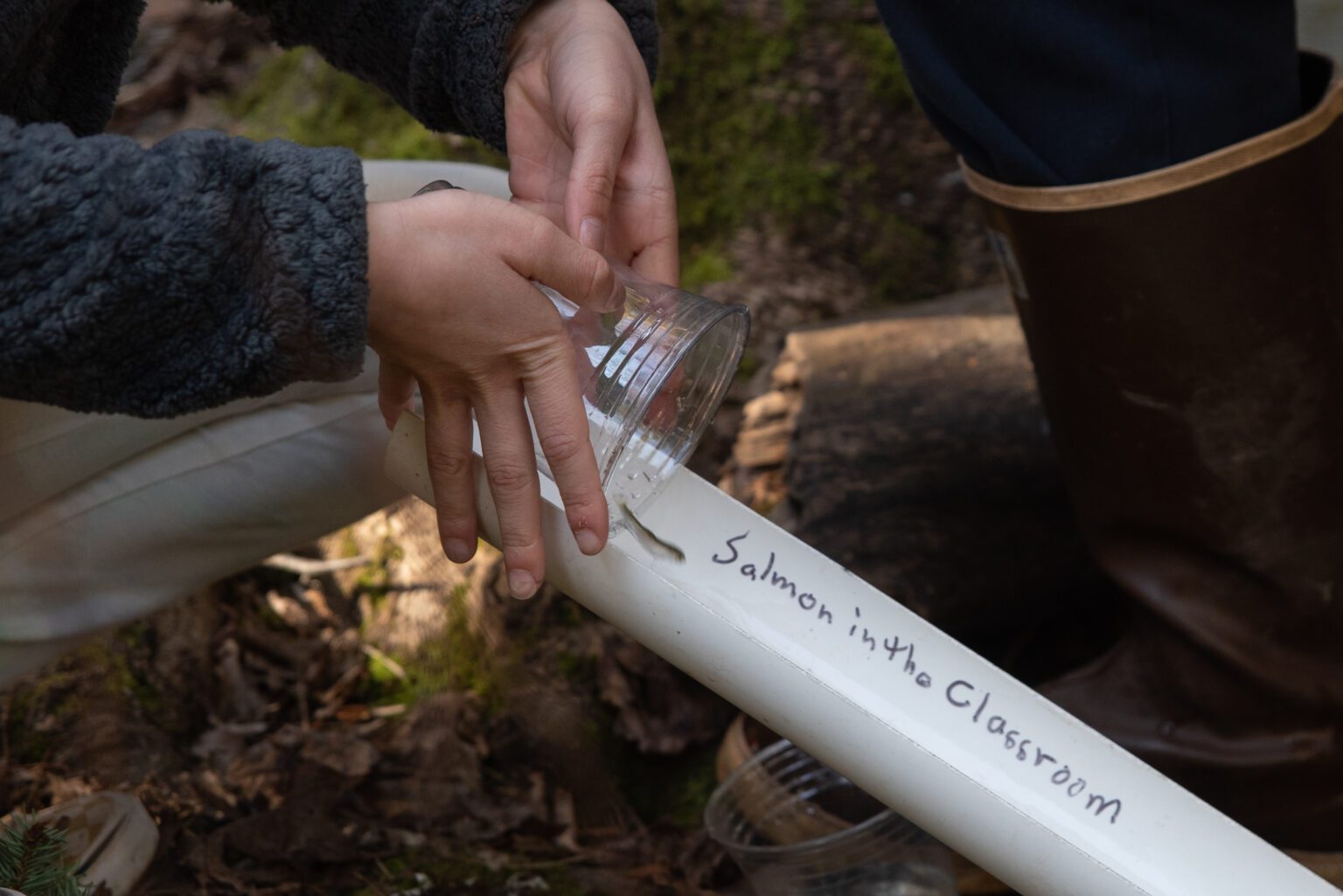Wade King Elementary School fourth graders gathered eagerly along the shaded bank of Padden Creek Thursday morning, March 30, preparing to bid farewell to nearly 300 chum salmon fry.
The students, who have been raising the fish since January, are participants of the Salmon in the Classroom program — a collaboration between the Washington Department of Fish and Wildlife (WDFW), Bellingham Public Schools, Bellingham Public Schools Foundation, Bellingham Technical College fisheries and aquaculture students and community volunteers.
The program is a part of the WDFW School Cooperative Program, and aims to support hands-on learning about salmon biology, habitats and stewardship. Each year, classrooms receive 300 eggs to raise in a school aquarium and later release as fry into local creeks.
“[Our creeks] are our living classrooms where people can learn about what is a healthy ecosystem, with an opportunity to do something,” said Wendy Scherrer, regional coordinator for the program. “This little fish project that we do begins a conversation at a kindergarten level and continues it.”
This is Wade King Elementary’s third year participating in the program. This year, two fourth-grade classrooms — Richard Bennett’s class and John Livezey’s class — helped raise and release the fry. Students also learned about water quality and riparian-zone health, and regularly monitored the water in the tank by testing for pH and nutrient levels.

“We’ve been learning how to take care and feed them and how to correctly temperature the water and change it, because we don’t want bacteria or any germs to get in the fish tank for them,” said Lyla, a student from Bennett’s class.
The day began on the second floor of Wade King Elementary, where fourth graders Ella, Nia and Aiden coalesced around the fish tank with Glen “Alex” Alexander, a program volunteer and retired education coordinator for Padilla Bay National Estuarine Research Reserve.
Together, the group worked to slowly transfer the fry from the aquarium to two bright orange Home Depot 5-gallon buckets, using a dip net to capture the half-dollar-long swimmers.
“They’re so cute,” said Alexander, adding that he’d even go so far as to call the little fish charismatic.
Once all the fry had been moved, they began their 5-gallon-bucket journey to Fairhaven Park — down the stairs, past a line of exuberant first graders and into the back of Alexander’s blue Toyota Highlander.
By 9:45 a.m., the Wade King fourth graders sent their aquatic friends into Padden Creek down a “salmon slide” into the creek. Each student counted the fish in a plastic cup and made a wish and promise.
Lyla, Nia and Aiden all wished for their fry to have a long life. Ella promised to ride in the car less to help reduce pollution in the creek.
“I had two fish, and I named one of them Two Percent because 2 percent of them make it back [to the creek], and I named one of them Lucky,” Ella said.
Nia named one of her fry Barely, because it looked barely alive. Other names included Potato, Sunshine and Bob III.
Once schools release their fry, they must evaluate the program and report their total count to WDFW. This year, Wade King Elementary counted 281 fry.
“These fish have been through a lot already, but they’ve been very well cared for by the students,” Alexander said. “These students have been working so hard to make sure that they survived, and now they’ve survived at a much higher rate than they would in the wild because of flooding, and predators and other problems that they can encounter naturally.”

The journey from school to creek gives just a glimpse into a much longer process.
Scherrer said by April each year, she needs to confirm which schools are interested in the Salmon in the Classroom program so she can apply for permits for the following year’s eggs through the Washington Department of Fish and Wildlife. In September and October, she begins recruiting and training teachers and volunteers. In November and December, the schools begin buying equipment, setting up the aquarium and preparing students. By mid-January, each school has 300 eggs in their aquarium. This year’s eggs come from Bellingham Technical College’s Whatcom Creek Hatchery.
Scherrer sees the Salmon in the Classroom program as an intergenerational learning experience that brings together students, parent and grandparent volunteers, young adults at Bellingham Technical College and city agencies.
It also localizes learning and problem-solving.
“You could learn about fish that live in some other part of the world. But here, these are our fish and these are our streams — this is my neighborhood,” Alexander said.
For him, those small steps are medicine against the sense of powerlessness that many people feel in facing big environmental issues.
“It builds hope, and that’s what we need in order to overcome even these big problems that we have,” Alexander said. “We can fix our streams and our environment, and we can save the salmon and we can save the orca whales. We just have to make small steps now.”
To learn more about the Salmon in the Classroom program contact Wendy Scherrer at bluegreen.northwest@gmail.com.




